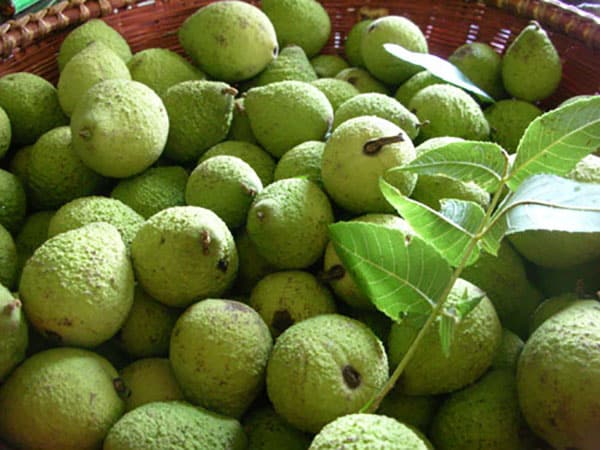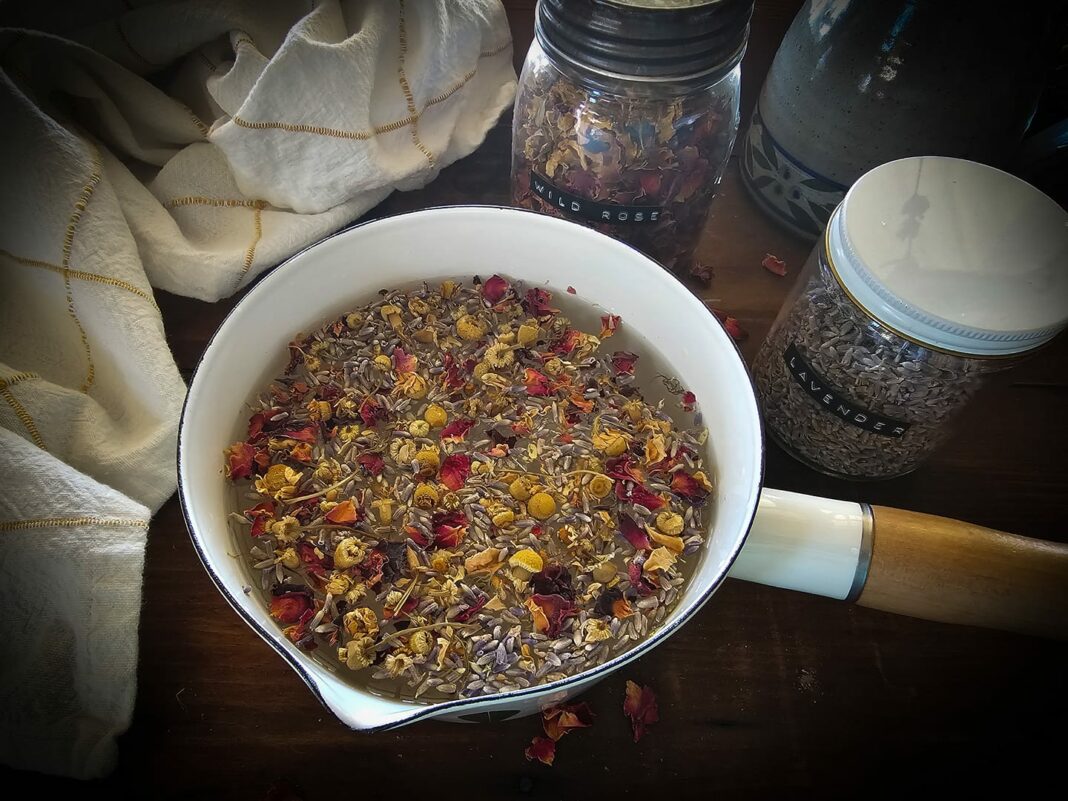WalnutGreen hullsHealing, purging, dyeingFew know of thisMedicine
You’ve probably sampled Walnuts in salads or cookies. The nut meat is prized for eating and is also pressed to create Walnut butter, which is similar to peanut butter, or Walnut oil, which can be used for cooking.
The trees can be tapped in the spring, similarly to maple trees for sap collection which can be cooked down to make Walnut syrup and sugar.
Even though only the nuts and sap are used for food, the hulls and inner bark also contain nutrients. Black Walnut hulls contain aluminum, calcium, chromium, cobalt, copper, iodine, iron, magnesium, manganese, niacin (B3), phosphorus, potassium, protein, riboflavin, selenium, silica, sodium, sulfur, thiamine (B1), tin, vitamins A and C, and zinc. The inner bark contains calcium, iodine, and silica. The nut contains beta-carotene, riboflavin (B2), vitamin C, manganese, and phosphorus.
Medicinally, the leaf, dried inner bark, green hull, rotten hull, and nut are all used for medicine.
Energetically, Walnut is bitter, astringent, cooling, and drying. This applies to the leaf, hulls, and inner bark while the nut is sweet, warming, and moistening. Black Walnut contains many constituents.
The leaf contains the napthquinone juglone, tannin, ellagic acid, gallic acid, flavonoids, inositol, and essential oils.
The inner bark contains the napthquinone juglone, tannins, and ellagic acid.
The hulls contain the napthquinone juglone.
The nut contains the essential fatty acids linoleic acid and linolenic acid and serotonin.
Medicinally, Black Walnut has many offerings.
The leaf is alterative, anthelmintic, antifungal, anti-inflammatory, antiseptic, antiviral, astringent, and detergent.
The inner bark is alterative, anthelmintic, antifungal, antiseptic, antiviral, astringent, cathartic, detergent, laxative, and purgative.
The hull is anthelmintic, antifungal, antiseptic, antiviral, astringent, detergent, laxative, sudorific, and vermifuge.
The nut is anti-inflammatory, bronchial dilator, and kidney tonic.
Because Black Walnut is high in tannins, he is extremely astringent, making him useful for healing inflammatory conditions of the bowel, including hemorrhoids. His leaf helps with diarrhea while the bark helps with constipation. Black Walnut can be combined with Dandelion to help with mild constipation.
As an anti-parasitic Black Walnut has been found to be effective in removing various parasites such as Giardia and other parasites that are present in the bowels. Combined with his astringent and anti-inflammatory actions, he soothes the bowel and destroys the pathogens.
Topically, he can be applied to ringworm, candida, athlete’s foot and other fungi growth on the skin though Walnut can be staining so should be used with that in mind.
Others have spoken of using Black Walnut topically for shingles outbreaks. I suspect it would be great for using on chicken pox as well since they both originate from the same virus.
The green hulls, leaves, and inner bark are all helpful for oxygenating the blood. A tea of the hulls has been used for deafness, pain in the ears, and tinnitus.
A flower essence from Walnut supports transitions, from puberty and menopause to moving house, changing jobs, going to a new school, or a change in relationship status while offering protection from the overstimulation that can come from outside forces. Walnut flower essence is also supportive to those who are trying to break free from bad habits and create new ones in their lives.
It is most common to find powdered Walnut hulls for use commercially; however, the leaves and twigs can be used with great success as well. For goiter and hypothyroidism, use only the rotten black walnut hulls (after they’ve turned black) in tincture form. For everything else, leaves, twigs, green or hulls can be used in tincture, oil or tea form.
In addition to being edible and medicinal, Walnut wood is used for building furniture and trim in houses, as well as burned for fire wood.
The hard black walnut shell is used commercially in abrasive cleaning, cosmetics and more.
Many parts of the tree can also be used as a dye. The leaves will give off a greener color while the hulls give a variety of shades from golden brown to deep brown, depending when they are harvested and used. The hulls are also boiled in water and the liquid boiled down to make brown ink.
Black Walnut Extract Recipe
Use the green hulls when making this tincture. If you need to make a tincture specifically for hypothyroidism and goiters associated with hypothyroidism, use the rotten walnut hulls (when they’ve turned black and gooey). This tincture is great for applying externally to any type of fungus. It can also be taken internally for parasites.
Note: You may wish to wear gloves when handling Black Walnut as it can be very staining.
Green Black Walnut hullsGrain alcoholWater
Chop the Walnut hulls into pieces with a knife.
Fill your jar halfway with the chopped hulls.
Fill the jar halfway with the grain alcohol then top off with water. Label your jar with the name, date and amount of alcohol and plant material.
Let steep for 4 weeks.
General Dosage
(3 times daily)
Adults:
Children:
15-30 drops
2-6 5-10 drops
7-12 10-15 drops
Want to learn to make Black Walnut Dye with your kids? Check out my new Monday Making series. This week’s episode is on making this fun dye!https://www.youtube.com/watch?v=8UlP0h1Nn2I&t=311s
Want to listen to “Black Walnut’s Creation”? This story is from the Black Walnut issue of Herbal Roots zine and it can be found on YouTube here: https://www.youtube.com/watch?v=wcKuj-qlO3I
Want to learn more about Black Walnut? You can find the Black Walnut eBook in my shop: https://herbalrootszine.com/product/black-walnut-issue-34/
Or, join Herb Club to get all the video lessons and extra curriculum for Black Walnut:https://herbalrootszine.com/join


